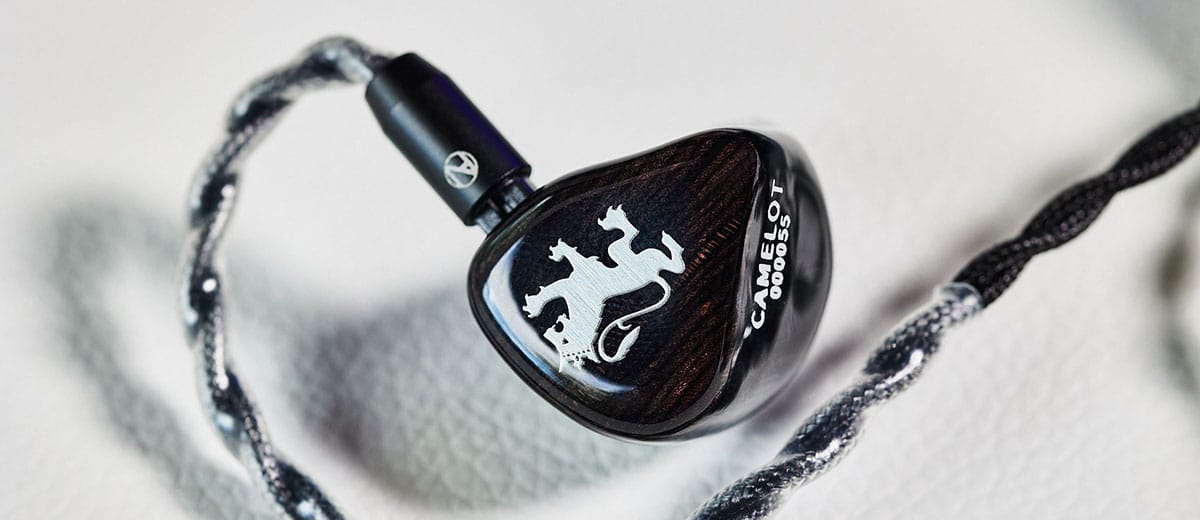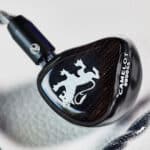In today’s feature, we review the Nostalgia Audio Camelot which is a new flagship 10-driver tribrid electrostatic universal in-ear monitor. It is priced at $2599.
Disclaimer: This is a sample sent to us in exchange for our honest opinion. Headfonics is an independent website with no affiliate links or status. We thank the team at Nostalgia Audio and Audio Essence for their support.
To read more about in-ear monitor products we have previously covered on Headfonics click here.
Note, that this article follows our latest scoring guidelines which you can read up on here.
We covered Nostalgia Audio around the same time last year with their debut 5-driver Benbulbin offering which did quite well. This year, the team from Nostalgia Audio has returned with a new and more ambitious hybrid project, their 10-driver Camelot
The price point is a lot higher also compared to the Benbulbin at $2599 placing it in flagship or TOTL territory and with some stiff competition out there already. So, does the Camelot soar high enough to compete among some of the best hybrid IEMs currently out there in the market? Read on to find out!
Tech Highlights
The Camelot is Nostalgia Audio’s flagship tribrid IEM packed with a ton of technical features. Housing 10 drivers, the Camelot manages to squeeze in two 10mm dynamic, 4 balanced armature, and 4 electrostatic into one single shell.
The two 10mm dynamic drivers handle the sub and mid-bass frequencies whilst the balanced armatures and electrostatic drivers take care of the midrange and treble. This is all threaded together with a 5-way crossover.
The two 10mm dynamic drivers are self-designed by Nostalgia Audio and are constructed with an N52 Neodymium magnet in tandem. The ultimate goal here is to deliver Nostalgia Audio’s “XBS or Extreme Bass System” which is supported by a brass chamber.
The Camelot also features “SFD or Spiral Flow Device” which is a special spiral construction within the IEM nozzle to reduce loss of sound quality caused by the curvature of the nozzle.
Design
The Camelot comes in a simple yet elegant design. The IEM shells are made from a 3D-printed resin and come in a jet-black color. Each shell is topped off with a dark brown faceplate which has a wood or timber-like texture.
To finish, the right-sided shell features a standing lion wearing a crown whereas the left shell wears the Nostalgia “NA” logo. The Camelot has an extended nozzle meaning that the insertion depth is quite deep.
Another nice feature of the IEM shells is that the 2-pin connect slot is slightly recessed ensuring that the cable connected to the IEM is tightly secured.
Comfort & Isolation
The Camelot’s shells are very ergonomic and feature a nicely curved section on the inner side of the shell from the top to the nozzle. Although the shells of the Camelot are quite large, there were no discomfort or fit issues even after hours of listening.
Going into the review and testing phase, I was positively surprised at how comfortable the Camelot was to wear on the ear despite its size.
From my experience, the combination of the long nozzle and stock tips provided is a crucial element in achieving a perfect seal and fit as the conical shape of the tips and long nozzle length allow an even distribution of weight across the nozzle to counter the large size of the Camelot’s shells.
The Camelot shells were able to isolate the sound effectively leaving no instances of sound leaking in or out of the IEMs.
Tips
The Camelot comes with a wide selection of ear tips spanning three different types. There are two main types of ear tips provided with sizes ranging from small, medium, and large.
The main difference between these ear tips is their composition as one set is made from soft, black silicone material with a flexible core whereas the other is constructed from a thicker, orange silicone material with a stiffened core or stem.
During my testing, the soft black silicone tips provided an overall better fit and seal and thus were favorable over the other set. The third and last type of ear tip is a medium-sized pair of foam ear tips that isolate well and are quite comfortable to use.
Stock Cable
The team from Nostalgia Audio has paired the Camelot with their in-house cable called the “Avalon” which is a 4-wire, 22 AWG High purity OFC and OCC Copper cable.
This is hands down, a fantastic cable and the perfect fit for a flagship IEM of this caliber. The cable features a multi-strand design and a thick but highly flexible nylon jacket. Speaking of flexibility, the cable is very supple and soft. It is well constructed with even braiding and sufficient tension to retain its shape.
At one end, the Avalon is finished with a 4.4mm rhodium-plated plug housed in a black metal casing with cut edges, topped with the Nostalgia Audio “NA” logo.
At the other end, the cable has a 2-pin system where the connectors are finished with a black metal casing. L and R letters help identify the left and right sides of the cable which are followed by a thick plastic layer on top of the ear hooks.
In the middle of the cable, the splitter and cable ring have the same, jet-black color and metal finish as the plug casing. The splitter itself is small and compact and features the words “Avalon” and “Nostalgia” written on the sides. To top it off, a brown cable strap is also included.
Overall, Nostalgia Audio has provided a very high-quality stock cable. If there was one wish for the future, it would be they would offer the Avalon as a standalone cable to complement the rest of their aftermarket cable range. Thus, opening it up to all audiophiles with and without a Camelot.
Packaging & Accessories
The Camelot comes pre-packaged in a black, rectangular box that features medieval artwork on the front. The artwork depicts Camelot at the top of a hill, surrounded by forest which leads to Excalibur or the Sword in the Stone in the foreground.
This is a nice touch from Nostalgia Audio as it links all aspects of the product together to the main theme: the Arthurian legend. As you open the main box, another one awaits inside which slides out like a small drawer containing the IEM and its accessories.
Aside from the provided ear tips, the Camelot comes with a circular, hockey puck-style case. The case is grey-blue with a suede-like finish.
The size of the case is on the larger side and provides more than enough space to hold the IEMs and Avalon cable. Finally, the lid of the case is stamped with the face of a lion and the word “Camelot”.
Sound Impressions
Summary
Overall, the Camelot has an absolutely gorgeous and effortlessly coherent sound signature. It has a slight bass boost, coupled with a forward lower mid-range and sparkly treble.
The pinnacle of the sound signature is derived from its highly resolving mid-range and 3D-esque soundstage. Once you have these IEMs running at full speed, it’s easy to get lost in the music.
Bass
The Camelot’s bass response is crisp, clean, and tight. Supported by Nostalgia Audio’s “Extreme Bass System”, the IEM is reliant on its two self-developed 10mm dynamic drivers to handle the sub and mid-bass frequencies.
By having two dynamic drivers, the Camelot can achieve a high-quality bass response. This is because it can layer its bass notes whilst offering some excellent imaging capabilities.
The word “Extreme” as the system suggests is not about the quantity of bass being extreme but rather the overall quality of the bass response. Hence, the goal of the Camelot is to produce a realistic bass response that focuses more on speed, resolution, and texture rather than quantity and slam.
The sub-bass does not rumble often and only digs deep when called upon. In other instances, the sub-bass is not subdued or missing but provides just enough foundation for the overall sound signature.
The mid-bass has a slight boost sounding punchy and controlled though it sits behind the midrange in terms of forwardness. Mid-bass notes decay can sound fast or slow depending on the note or instrument itself giving it a sense of realism.
Furthermore, mid-bass notes are handled effortlessly and are presented with a very high level of detail and texture. For example, the distinct sound and texture of snare and kick drums can really be “felt and heard” as the Camelot can allocate an appropriate amount of decay, layering, and resolution.
Mids
The Camelot midrange sounds highly resolving, natural, and coherent in its performance. This is a slightly warm timbre which allows the midrange to come off with a natural-sounding tone.
The lower mid-range is at the forefront of the overall sound signature sounding the most forward. This is closely followed by the upper midrange which sits just behind the lower mid-range.
The upper mid-range is not too far forward that it becomes too harsh but instead is placed in a suitable manner where instruments and vocals come off as incredibly smooth, and detailed.
The Camelot detects and presents micro-details with ease which allows anyone to easily appreciate the music being presented.
For example, the sound and texture of guitars and violins being strung, piano keys being tapped, and male and female vocals are presented effortlessly with a high level of clarity, air, and space.
Treble
The Camelot has a sparkling treble presentation with incredible extension and a high level of detail. Presented by the 4 electrostatic drivers, high hats and cymbals sound very refined and with enough zing to make them noticeable throughout the sound signature.
They also have enough energy to support the upper mid-range but not too much to make them sound too bright or sibilant. Instead, the treble response is very articulate allowing you to pick out a lot of high-frequency micro-details.
Staging & Imaging
The soundstage on the Camelot is very wide and tall and is presented in a manner that gives an overall 3D effect to the sound signature. The staging width is not linear and even extends diagonally.
Layering and imaging from the Camelot are very accurate and holographic sounding creating multiple layers with plenty of spacing between instruments and vocals.
Instruments and vocal imaging are placed with pinpoint accuracy allowing for an encapsulating and enveloping listening experience.
Click on page 2 below for pairings and our select comparisons










